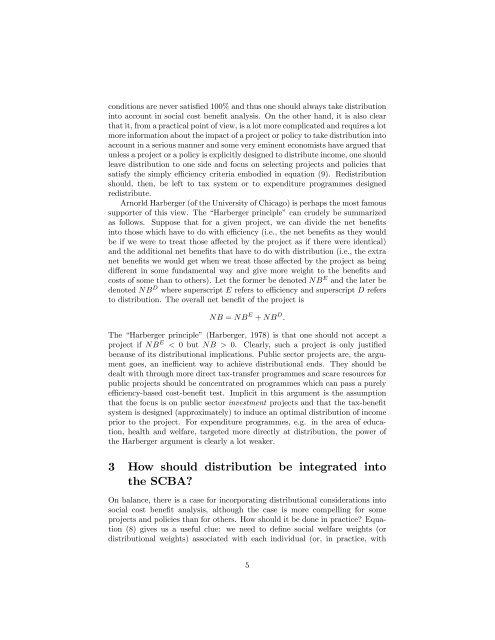Lecture Note 15: Social Cost Benefit Analysis - University of ...
Lecture Note 15: Social Cost Benefit Analysis - University of ...
Lecture Note 15: Social Cost Benefit Analysis - University of ...
Create successful ePaper yourself
Turn your PDF publications into a flip-book with our unique Google optimized e-Paper software.
conditions are never satis…ed 100% and thus one should always take distribution<br />
into account in social cost bene…t analysis. On the other hand, it is also clear<br />
that it, from a practical point <strong>of</strong> view, is a lot more complicated and requires a lot<br />
more information about the impact <strong>of</strong> a project or policy to take distribution into<br />
account in a serious manner and some very eminent economists have argued that<br />
unless a project or a policy is explicitly designed to distribute income, one should<br />
leave distribution to one side and focus on selecting projects and policies that<br />
satisfy the simply e¢ ciency criteria embodied in equation (9). Redistribution<br />
should, then, be left to tax system or to expenditure programmes designed<br />
redistribute.<br />
Arnorld Harberger (<strong>of</strong> the <strong>University</strong> <strong>of</strong> Chicago) is perhaps the most famous<br />
supporter <strong>of</strong> this view. The “Harberger principle” can crudely be summarized<br />
as follows. Suppose that for a given project, we can divide the net bene…ts<br />
into those which have to do with e¢ ciency (i.e., the net bene…ts as they would<br />
be if we were to treat those a¤ected by the project as if there were identical)<br />
and the additional net bene…ts that have to do with distribution (i.e., the extra<br />
net bene…ts we would get when we treat those a¤ected by the project as being<br />
di¤erent in some fundamental way and give more weight to the bene…ts and<br />
costs <strong>of</strong> some than to others). Let the former be denoted NB E and the later be<br />
denoted NB D where superscript E refers to e¢ ciency and superscript D refers<br />
to distribution. The overall net bene…t <strong>of</strong> the project is<br />
NB = NB E + NB D :<br />
The “Harberger principle” (Harberger, 1978) is that one should not accept a<br />
project if NB E < 0 but NB > 0. Clearly, such a project is only justi…ed<br />
because <strong>of</strong> its distributional implications. Public sector projects are, the argument<br />
goes, an ine¢ cient way to achieve distributional ends. They should be<br />
dealt with through more direct tax-transfer programmes and scare resources for<br />
public projects should be concentrated on programmes which can pass a purely<br />
e¢ ciency-based cost-bene…t test. Implicit in this argument is the assumption<br />
that the focus is on public sector investment projects and that the tax-bene…t<br />
system is designed (approximately) to induce an optimal distribution <strong>of</strong> income<br />
prior to the project. For expenditure programmes, e.g. in the area <strong>of</strong> education,<br />
health and welfare, targeted more directly at distribution, the power <strong>of</strong><br />
the Harberger argument is clearly a lot weaker.<br />
3 How should distribution be integrated into<br />
the SCBA?<br />
On balance, there is a case for incorporating distributional considerations into<br />
social cost bene…t analysis, although the case is more compelling for some<br />
projects and policies than for others. How should it be done in practice? Equation<br />
(8) gives us a useful clue: we need to de…ne social welfare weights (or<br />
distributional weights) associated with each individual (or, in practice, with<br />
5


